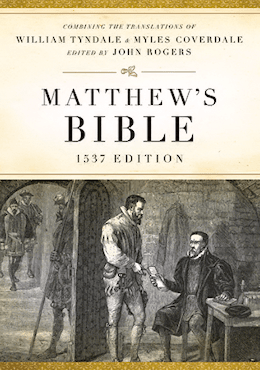Textus Receptus Bibles
Matthew's Bible 1537
| 5:1 | There goeth a commen, saiynge: that there is fornicacion amonge you, and such fornication as is not ones named amonge the Gentiles: that one should haue his fathers wyfe. |
| 5:2 | And ye swell and haue not rather sorowed, that he whiche hath done this dede, myght be put from amonge you. |
| 5:3 | For I verelye as absent in bodye, euen so present in spirite, haue determined alredye (as though I were present) that he that hath done this dede, |
| 5:4 | in the name of oure Lord Iesus Christ, when ye are gathered together, in my spyryte, wyth the power of the Lorde Iesus Christe, |
| 5:5 | be delyuered vnto Sathan, for the destruccion of the fleshe, that the spirite maye be saued in the daye of the Lorde Iesus. |
| 5:6 | Your reioysing is not good: knowe ye not that a lytle leuen sowreth the whole lompe of dowe. |
| 5:7 | Pourge therfore the olde leuen, that ye may be new dowe, as ye are swete bread. For Christ oure easterlambe is offered vp for vs. |
| 5:8 | Therfore let vs kepe holy daye, not wyth olde leuen, neither with the leuen of malycyousnes and wyckednes, but with the swete bread of purenes and trueth. |
| 5:9 | I wrote vnto you in an Epystle that ye shoulde not companye wyth fornicatours. |
| 5:10 | And I meant not at al of the fornicatours of this worlde, eyther of the couetous, or of extorsioners, eyther of the ydolaters: for then muste ye nedes haue gone oute of the world. |
| 5:11 | But nowe I writte vnto you, that ye companye not together, if anie that is called a brother be a fornicatour, or couetous, or a worshiper of ymages, eyther a raylar, either a drounkard, or an extorcionar: with him that is such, se that ye eate not. |
| 5:12 | For what haue I to do, to iudge them which are without? Do ye not iudge them, that are within? |
| 5:13 | Them that are wythout, God shal iudge. Put awaye from amonge you, that euyl person. |

Matthew's Bible 1537
The Matthew Bible, also known as Matthew's Version, was first published in 1537 by John Rogers, under the pseudonym "Thomas Matthew". It combined the New Testament of William Tyndale, and as much of the Old Testament as he had been able to translate before being captured and put to death, with the translations of Myles Coverdale as to the balance of the Old Testament and the Apocrypha, except the Apocryphal Prayer of Manasses. It is thus a vital link in the main sequence of English Bible translations.